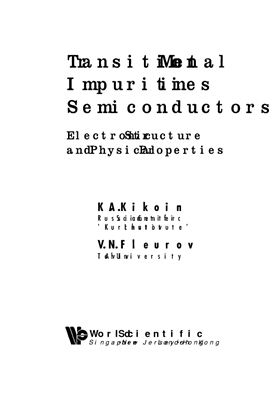Wоrld Sciеntific, 1994, 349 pages
This volume discusses the theory of the electron states of transition metal impurities in semicondutors in connection with the general theory of isoelectronic impurities. It contains brief descriptions of the experimental data available for transition metal impurities (from iron, palladium and the platinum groups) and rare-earth impurities in various semiconductor compounds. The applications of the theory to the optical electrical and resonance properties of semiconductors doped by transition metal impurities is also presented. The theory presented unifies previously-proposed ligand-field and band descriptions of transition metal impurities and is described in the context of the general theory of neutral impurities in semiconductors. The capabilities of this description for explaining the basic experimental properties of semicondutors doped by transition metal impurities is also detailed. This study is based mainly on original works by the authors as well as other relevant papers and is illustrated by many results of numerical calculations which support the principal ideas of the theory. There is a discussion of various experimental results and their theoretical interpretation. The first two parts of the book consider several exactly solvable models, describe numerical techniques and present all these as mutually connected parts of a general patte of the theory of simple, transition metal and rare-earth impurities in semiconductors. The third part uses this theory in order to address various experimentally observed properties of these systems.
This volume discusses the theory of the electron states of transition metal impurities in semicondutors in connection with the general theory of isoelectronic impurities. It contains brief descriptions of the experimental data available for transition metal impurities (from iron, palladium and the platinum groups) and rare-earth impurities in various semiconductor compounds. The applications of the theory to the optical electrical and resonance properties of semiconductors doped by transition metal impurities is also presented. The theory presented unifies previously-proposed ligand-field and band descriptions of transition metal impurities and is described in the context of the general theory of neutral impurities in semiconductors. The capabilities of this description for explaining the basic experimental properties of semicondutors doped by transition metal impurities is also detailed. This study is based mainly on original works by the authors as well as other relevant papers and is illustrated by many results of numerical calculations which support the principal ideas of the theory. There is a discussion of various experimental results and their theoretical interpretation. The first two parts of the book consider several exactly solvable models, describe numerical techniques and present all these as mutually connected parts of a general patte of the theory of simple, transition metal and rare-earth impurities in semiconductors. The third part uses this theory in order to address various experimentally observed properties of these systems.

